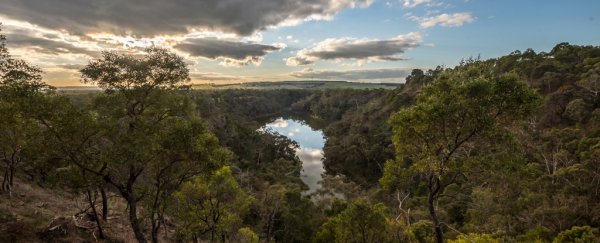A long, long time ago, the Indigenous Gunditjmara people – the traditional owners of lands in southwest Victoria, Australia – are said to have witnessed something truly remarkable.
An ancient oral tradition, passed down for countless generations, tells of how an ancestral creator-being transformed into the fiery volcano, Budj Bim. Almost 40,000 years later, new scientific evidence suggests this long-shared legend of the Dreaming could be much more than a myth.
New mineral-dating measurements conducted by Australian scientists highlight the possibility that the traditional telling of Budj Bim's origins may be an actual account of two historic volcanic eruptions that took place in the region about 37,000 years ago – which, if true, might make this the oldest story ever told on Earth.
"If aspects of oral traditions pertaining to Budj Bim or its surrounding lava landforms reflect volcanic activity, this could be interpreted as evidence for these being some of the oldest oral traditions in existence," the researchers, led by geologist Erin Matchan from the University of Melbourne, write in their study.
Up until now, most evidence for the oldest known human habitation in Australia comes from radiocarbon dating or optically stimulated luminescence (OSL) dating, using samples of ancient charcoal, or sediments from rock shelters.
Unfortunately, a lack of both ceramic artefacts and permanent structures in the Indigenous Australian context makes finding archaeological samples a challenge. Only six sites in southeast Australia have been definitively dated to older than 30,000 years, the researchers say – despite evidence from elsewhere in the country suggesting it could have been inhabited as far back as 65,000 years ago, or even older.
Luckily, recent technological advancements in an alternative technique called argon–argon dating could provide new ways of dating volcanic rock in the southeast landscape, especially when coupled with interpretations of cultural knowledge, the authors suggest.
"The oral traditions of Australian Aboriginal peoples have enabled perpetuation of ecological knowledge across many generations, providing a valuable resource of archaeological information," Matchan and study co-author David Phillips explain in an article summarising their findings.
"Some surviving traditions appear to reference geological events such as volcanic eruptions, earthquakes, and meteorite impacts, and it has been proposed that some of these traditions may have been transmitted for thousands of years."
In the case of the now-extinct Budj Bim volcano, and another nearby inactive volcano located 40 kilometres (25 mils) away, called Tower Hill, we now have a better estimate of just how many thousands of years ago their ancient eruptions happened, thanks to the argon–argon technique.
In the new research, the team dated a sample from a lava bomb hurled from the historic Tower Hill eruption, along with a sample of lava flow from Budj Bim's eruption.
The results suggest the eruptions may have been contemporaneous, with lava dated to 36,800 years ago (± 3,800 years) for Tower Hill, and 36,900 years ago (± 3,100 years) for Budj Bim.
Given Tower Hill's eruption was the most recent comparatively, the researchers suggest its eruption age "directly constrains a minimum age for human presence in Victoria".
That conclusion is based on the existence of a lone stone axe – called the 'Bushfield axe' – which was previously discovered buried beneath a layer of volcanic rock and ash from the eruption, and is therefore considered to be evidence of contemporaneous human occupation in the area.
As for whether the long-told oral tradition of Budj Bim truly chronicles these awesome, ancient volcanic outbursts, it's impossible to be sure. Some researchers say we need to be cautious about how we interpret stories from so long ago.
But we should also be curious.
"We in the West have only scratched the surface of understanding the longevity of Australian Indigenous oral histories," archaeologist Ian McNiven from Monash University told Science.
The findings are reported in Geology.
